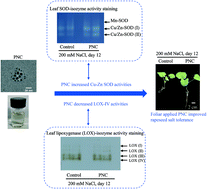CeO2 nanoparticles modulate Cu–Zn superoxide dismutase and lipoxygenase-IV isozyme activities to alleviate membrane oxidative damage to improve rapeseed salt tolerance†
Abstract
Rapeseed is an important cash crop. However, its yield and quality are significantly affected by salinity stress. Salinity stress causes ROS-overaccumulation in plants and limits their yield and quality. Cerium oxide nanoparticles (nanoceria) are potent ROS scavengers. In this study, poly(acrylic) acid-coated nanoceria (PNC, 8.36 nm, −25.3 mV) was foliarly applied. Our results showed that compared with the control, PNC improved rapeseed salt tolerance, showing a significantly increased chlorophyll content (64%), carbon assimilation rate (110%), leaf length (31%) and width (25%), and fresh weight (50%). Under salt stress, PNC treated rapeseed showed a significantly lower MDA content (18.9%) and electrolyte leakage index (25%) than the control, suggesting that PNC protected the leaf cell membrane from oxidative damage. Evans's blue and PI staining results further confirmed that PNC protected the leaf cell membrane integrity under salt stress. Confocal imaging results showed that PNC treated rapeseeds have significantly lower dye intensities of ˙O2− (21%) and H2O2 (51%) than the control under salt stress. This is further confirmed by NBT and DAB histochemical staining. After 5 days of salt stress, compared with the control, PNC increased SOD activities in rapeseed plants. Interestingly, gene expression analysis showed that only Cu–Zn SOD but not Mn-SOD and Fe-SOD was upregulated. Isozyme electrophoresis results further confirmed that under salt stress, both Cu–Zn SOD-I (81% increase) and -II (40% increase) activities are significantly higher in PNC treated rapeseed than the control. Moreover, under salt stress, PNC treated rapeseed showed significantly lower lipoxygenase (LOX) activities and downregulated expression levels of LOX-2 and LOX-3 genes compared with the control. Further, only LOX-IV isozyme activities are significantly reduced in PNC compared with buffer treated plants under salt stress. Overall, our results suggest that under salinity, PNC modulates Cu–Zn SOD and LOX-IV activities to alleviate oxidative damage on the cell membrane to improve rapeseed salt tolerance. Our results not only pointed out the research needs at the isozyme level but also added more information on mechanisms underlying nanoceria improved plant salt tolerance.

- This article is part of the themed collection: Nano-bio interactions


 Please wait while we load your content...
Please wait while we load your content...